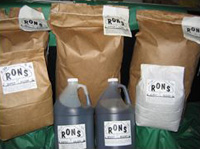 |
||
Ron’s ArticlesOnly the Strong SurviveDecember 2005
This forced me to open Mesquite’s first organic garden center. Little did I know what this would cost me, my family, employees and lawn business. We struggled and suffered many failures along the way. But those failures taught me lots of valuable lessons - especially about container plants. As you bring your potted plants inside for the winter, what I’ve learned may help. I was stocking my garden center with plants from commercial growers. And I was flushing my money down the drain. I knew what caused plants to die - that disease, insect pests and decline are symptoms of too much or too little food, water or light or temperature extremes or use of an improper soil medium. But, despite my efforts, my plants were under constant stress. I was spraying weekly for pests and disease. That didn’t make sense financially. Sick plants don’t sell and dead plants don’t lie. Something was terribly wrong. I studied my books and consulted my organic friends to no avail. I was desperate. Closing down looked like the best bet. But, late one day after all my customers and employees had left, I decided to look to my plants for answers. I walked through my center studying every plant, I touched them and smelled them. The answers were there! Commercial growers use a light sterile light soil medium that allows for root growth, drainage and circulation. But it’s incompatible with the organic program. We need a symbiotic relationship between microorganisms, air, food, water and the plant itself. I set out to repot my plants in the optimum medium. That turned out to be equal parts of totally digested compost and fine pine bark plus 10 to 15% oat, rice or pecan hulls. Finished compost doesn’t generate harmful heat. The hulls allow for good drainage and root movement. I think oat hulls are the best because they stimulate beneficial bacteria. Always soak transplant’s roots in Ron’s Root Right or a root stimulator. Ron’s Root Right is a mixture of my Super Sauce, molasses, vitamins and hormones. Do not position the plant too deep. This is a big problem in the nursery industry today. The root flare should be exposed. Do not mix any fertilizer into the planting medium. It stimulates too much activity and generates root-damaging heat. Instead, top dress with a 1/16th inch of a 50/50 mixture of Ron’s Super Castings and Super Blend or Super Bloom depending on the type of plant. Look again to nature. Earthworms deposit their casting on the surface of the soil. Each time you water, you make a mineral tea leachate that stimulates every root. Plus, it’s fun to watch the fungal life on the surface. Avoid tap water. It’s pH is too high and it’s treated to destroy bacteria and fungus. Plants tolerate pH between 7.5 and 6.5. Rain water is best. And, it’s free. Stick a barrel under your downspout and you’ll collect a lot of water from even a brief shower. Cover it with a layer of window screen to discourage mosquitoes. Next best is pond water or well water. If you must use tap water, draw it into a wide mouth container and allow it to sit overnight so some of the chlorine dissipates. Add 1 to 5% of Ron’s Super Sauce or something similar. I truly believe that my Super Sauce is superior. It contains free range cow manure compost tea, alfalfa-fed rabbit tea, coffee tea, seaweed, liquid fish, apple cider vinegar and molasses, soil stimulator, orange oil, neem oil, garlic, potassium bicarbonate, 36 natural mined minerals, diatomaceous earth, natural vitamins and hormones - and 20 years worth of my accumulated landscape knowledge. It will give your plants a mild health tonic every time you water. My final tip this month: Before it gets too cold, walk your property. Let nature communicate with you. Reflect on your failures and defeats. Remember, if it didn’t kill you, it only made you stronger. And, only the strong survive. Next month I’ll give you more information on last year’s victories and defeats in hopes of helping you make better landscaping decisions in 2006. 
|
|
|


|
||
